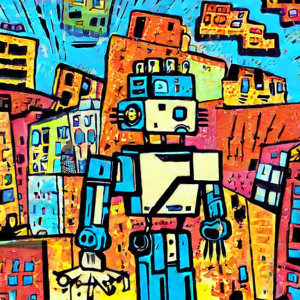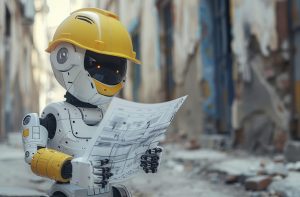
Artificial Intelligence (AI) has come a long way since its inception and has transformed numerous industries, including healthcare, finance, and transportation. It has revolutionized medical diagnoses, enabling more accurate and timely identification of diseases.
In the financial sector, AI algorithms analyze vast amounts of data, providing insights for better investment strategies and risk management.
Self-driving cars powered by AI are on the verge of transforming transportation by enhancing safety and efficiency. These examples are just the tip of the iceberg as AI continues to infiltrate and redefine many industries.
As we stand on the cusp of a new era characterized by rapid advancements in technology, it becomes imperative to explore the future of AI and the trends and predictions that will shape its trajectory.
Looking forward, we can expect AI to play an even more critical role in shaping the future. With advancements in computing power, data availability, and algorithm development, AI is poised to become more sophisticated, intelligent, and ubiquitous.
Let’s delve into the key AI trends and predictions that will likely drive its future, revolutionizing how we live, work, and interact with technology.
What Is the Current State of AI?
The current state of AI reflects a rapidly evolving and dynamic field that is making significant strides in various domains. AI technology has advanced considerably in recent years, fueled by breakthroughs in machine learning, deep learning, natural language processing, and computer vision. These advancements have enabled AI systems to perform complex tasks with remarkable accuracy and efficiency.
As mentioned earlier, in terms of practical applications, AI is already deeply integrated into many aspects of our lives. Virtual assistants like Siri, Alexa, and Google Assistant have become commonplace, providing voice-activated assistance for tasks such as setting reminders, answering questions, and controlling smart home devices. AI algorithms power:
- Recommendation systems on e-commerce platforms
- Personalized content suggestions on streaming services
- Targeted advertising on social media.
AI is also transforming industries such as healthcare, where it is being used to:
- Analyze medical images
- Assist in diagnosing diseases
- Develop personalized treatment plans.
In finance, AI is employed for fraud detection, algorithmic trading, and credit scoring. Autonomous vehicles powered by AI are undergoing testing and implementation, promising safer and more efficient transportation.
The availability of vast amounts of data and the ever-increasing computational power have fueled the progress of AI. The advent of big data and cloud computing has facilitated the training of complex AI models on massive datasets, enabling systems to learn patterns, make predictions, and provide valuable insights.
However, despite these remarkable achievements, there are still challenges and limitations in the current state of AI. One significant challenge is the issue of AI bias, which can perpetuate unfair outcomes and discrimination. AI models are only as good as the data they are trained on, and if the training data is biased or unrepresentative, the AI system’s decisions may reflect those biases.
Another challenge is the lack of transparency and interpretability in some AI models. Deep learning models, for example, are often referred to as black boxes, as they provide accurate results but offer limited insight into how they arrived at those conclusions. This lack of explainability raises concerns about trust, accountability, and potential errors or biases in decision-making.
Additionally, ethical considerations surrounding AI, such as privacy and data protection, are critical. The collection and use of personal data for training AI models raise concerns about individual privacy and the potential for misuse or unauthorized access.
Despite these challenges, the current state of AI is undeniably transformative. AI technology continues to advance rapidly, and its impact on society will grow even more profound in the future.
AI Trends to Watch
Trend 1: Democratization of AI
One of the most significant AI trends is democratization. The democratization of artificial intelligence is a trend that refers to making AI more accessible and usable by individuals and organizations that may not have had access to it before.
Earlier, only giant organizations could afford to develop and utilize AI. Today, small and medium-sized businesses—and even individuals—can leverage AI due to the development of pre-built machine learning models, the integration of AI tools in cloud platforms, and the emergence of automated machine learning tools.
They can build AI-powered products using cloud-based AI platforms like Google Cloud, Amazon Web Services (AWS), and Microsoft Azure. These platforms offer drag-and-drop interfaces that make it easy for users with little to no coding experience to build applications and models.
The democratization of AI has also made it easier for industries such as healthcare and education to utilize AI in their day-to-day operations. For example, healthcare professionals leverage AI to diagnose illnesses faster and more accurately. Similarly, AI-powered virtual classrooms have made it easier for students to learn from anywhere in the world.
This trend is set to continue in the coming years—with the rate of AI adoption increasing—allowing organizations to innovate, improve products and services, and stay competitive. With advances in technology and more user-friendly platforms, the barriers to accessing AI have been significantly lowered.
Trend 2: Explainable AI
As AI systems become more complex and are used more frequently, they need to be transparent and explainable. Experts predict that explainable AI will be huge, allowing users to understand how a particular decision was made.
This is significant in healthcare, military, and finance, where incorrect predictions could result in serious consequences. As AI systems grow more sophisticated, they will need to be understandable to those lacking technical expertise, leading to more accurate decision-making.
In many real-world applications, it’s important to understand how a particular decision was made by an AI system, especially if it could have a significant impact on people’s lives. However, many complex AI models are often referred to as “black boxes” because it’s difficult to interpret why they produce a certain output.
There are various methods for making AI models more explainable. These include:
- Using decision trees
- Rule extraction
- Feature importance analysis
Researchers and practitioners are also working on developing new ways to explain AI models, such as using natural language generation techniques to create human-readable explanations.
Explainable AI has become a growing area of interest in recent years, particularly as the use of AI across industries has become more widespread.
As more AI systems are developed, it’s increasingly important to ensure that they are transparent and interpretable so that we can better understand and trust their output.
Trend 3: Virtual Assistants
AI-powered voice assistants like Siri, Alexa, and Google Assistant have been around for years. However, these virtual assistants are set to become smarter and even more pervasive, assisting individual users and businesses worldwide. These voice assistants have made our lives so much easier, helping us with tasks like scheduling appointments, setting reminders, playing music, and answering our questions.
It’s estimated that by 2023, 8 billion virtual assistants will be in use. Moreover, with the advancements in natural language processing (NLP) and machine learning, these virtual assistants are becoming more intuitive, offering human like conversations, allowing us to interact with them more naturally.
Generative AI chatbots will begin to perform more complicated tasks than merely responding to simple queries. As virtual assistants become more sophisticated, they’ll better understand spoken and written language, respond more accurately and faster to requests, and provide higher-level assistance to users.
Trend 4: Automated Vehicles
The rise of automated vehicles is set to disrupt the transportation industry. We’re already witnessing self-driving cars, and the global market for autonomous vehicles is forecasted to reach $2,161.79 billion by 2030.
Automated vehicles promise to reduce accidents, save lives, and provide efficient travel. Autonomous cars are set to become the norm, with the technology spreading to all types of vehicles, including commercial and military applications.
With the advancements in autonomous technology, AI enables self-driving vehicles to operate safely and efficiently on the roads. AI-powered systems are being used for object detection, lane departure warnings, auto-braking, and adaptive cruise control, making vehicles safer for everyone on the road.
Not only do autonomous vehicles have the potential to reduce accidents caused by human error, but they could also potentially decrease traffic congestion, improve fuel efficiency and reduce emissions. However, there are still some challenges to overcome, such as regulatory and safety concerns, before we see widespread adoption of automated vehicles.
AI Predictions for the Future
Prediction 1: Job Displacement
While there are many positive aspects to AI, the potential negative impact it could have on employment is a genuine concern. As AI becomes more prevalent in the workforce, many routine and manual jobs are set to be automated. It’s not just low-skilled jobs that are at risk; AI could replace or overhaul many high-level jobs.
Here are a few examples:
- Manufacturing and Warehouse Operations: AI-powered robots and automated systems are already being employed in manufacturing and warehouse environments. These robots can perform repetitive tasks with high precision and efficiency, potentially reducing the need for human workers in assembly lines, packaging, and material handling.
- Customer Service and Support: AI-powered chatbots and virtual assistants are increasingly being used to handle customer inquiries and support. These systems can understand and respond to customer queries, provide troubleshooting assistance, and even complete basic transactions. While this improves efficiency and reduces costs for businesses, it may result in reduced employment opportunities for human customer service representatives.
- Transportation and Delivery Services: The rise of autonomous vehicles and drones powered by AI has the potential to disrupt the transportation and delivery industries. Self-driving trucks could replace human truck drivers, while delivery drones could automate last-mile deliveries. This could lead to job losses for truck drivers and delivery personnel.
- Data Analysis and Decision-Making: AI algorithms are adept at analyzing vast amounts of data and deriving actionable insights. This has implications for jobs that involve data analysis, such as financial analysis, market research, and data science. AI-powered systems can process data more efficiently and provide faster, more accurate results, potentially reducing the need for extensive human analysis.
While these examples highlight the potential displacement of jobs, it’s important to note that the rise of AI also has the potential to create new job opportunities and stimulate economic growth.
Prediction 2: Concentration of AI Development Among Tech Giants
Another concern in the AI space is the concentration of wealth and power among the tech giants who can afford to develop and utilize AI technology. While the democratization of AI means that smaller organizations can take advantage of AI, the scale and funding required to develop the most sophisticated AI systems are still only available to large technology companies.
As such, it’s imperative that policymakers and business leaders ensure a balance of power is maintained and that the benefits of AI are accessible to all. As we continue to develop and deploy AI technologies, we must address these concerns and ensure that the benefits are distributed fairly and equitably.
There is no doubt that AI will continue to play a major role in many different industries in the coming years. By staying informed and aware of the latest developments and trends, we can all stay ahead of the curve and take advantage of the many opportunities that AI has to offer.
Prediction 3: Ethical AI Development
Ethical AI development is becoming increasingly crucial as AI systems become more pervasive in our daily lives. There is growing awareness of the potential risks and negative consequences associated with AI, including algorithmic biases, privacy concerns, and the potential for automation to displace jobs. As a result, there will be a stronger emphasis on developing AI systems that prioritize fairness, transparency, and unbiased decision-making.
One of the key challenges in ethical AI development is mitigating algorithmic biases. AI algorithms learn from vast amounts of data, and if the training data contains biases or reflects societal prejudices, the AI system can perpetuate and amplify those biases. Efforts will be made to address this issue by ensuring diverse and representative training datasets, using bias detection and mitigation techniques, and fostering collaboration between AI developers and domain experts to identify and rectify biases.
Privacy and data protection will also be significant considerations in ethical AI development. As AI systems rely on vast amounts of personal data to function effectively, there will be a focus on implementing robust privacy safeguards, including secure data storage, anonymization techniques, and informed consent mechanisms. Stricter regulations and guidelines are expected to be put in place to govern the collection, use, and storage of personal data in AI applications.
Ethical AI development will enable us to build trust in AI systems, address concerns about bias and privacy, and foster a more inclusive and equitable future driven by AI.
What the Future Holds for AI
The future of AI is a complex landscape with both tremendous potential and challenges. As AI continues to advance, we can expect it to play a crucial role in shaping various industries and transforming the way we live and work.
The democratization of AI allows smaller organizations and individuals to leverage its power, fostering innovation and competitiveness. The rise of explainable AI addresses the need for transparency and accountability, ensuring that AI systems’ decisions can be understood and trusted.
Virtual assistants are becoming increasingly intuitive, offering personalized assistance and streamlining everyday tasks. Furthermore, the advent of automated vehicles holds the promise of improved road safety and efficiency.
However, it is essential to consider the potential impact on employment. While AI automation may lead to job displacement in routine and manual tasks, there is also the potential for new job opportunities to emerge as AI technology evolves. The challenge lies in preparing the workforce for the changing demands and ensuring a balance between job replacement and creation.
As AI continues to advance, it is crucial to address ethical considerations, such as bias, privacy, and accountability. Efforts to develop trustworthy and transparent AI systems will be paramount to ensure widespread adoption and acceptance.
Ultimately, the future of AI holds immense potential for driving innovation, enhancing productivity, and improving the quality of our lives. By staying informed, embracing the opportunities, and addressing the challenges, we can harness the power of AI to create a better future.




